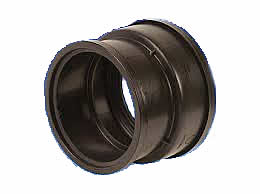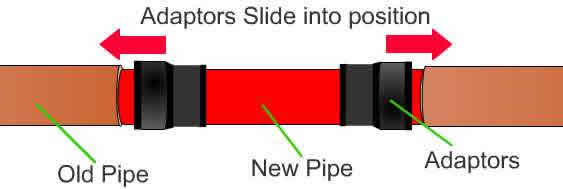
Most Visited
Rats In Your Home
Drain Flies
Why Drains Block
Internal Venting
Who`s Drain Is It ?
Drain Surveys
No-Dig Repairs
Drain Location
Drain Rods Stuck
Find A Contractor
Drain Pipe Work
Clay Drain Pipes
Plastic Pipe Work
Pitch Fibre Pipes
Cast Iron Pipes
Concrete Pipes
Drainage Parts
Drain Gullies
Dropshafts
Interceptor Traps
Soil Vent Pipes
Anti-Flood Valves
Manholes
Drain Repairs
Excavations
Drain Lining
Patch Lining
Pipe Bursting
Re-Rounding
Drainage
Investigations
Drain Surveys
Sonar Tracing
Updated 27 April, 2014
draindmain.com > site map > drainage pipe adaptor couplings
Drainage Pipe Adaptor Couplings
Over time these clay pipes were developed and came in longer lengths with thinner pipe walls, we then had pitch fibre pipes for a short time (thankfully) and along came plastic pipework including the now popular twin walled systems. The early challenge was to find a way of connecting the modern materials to the old Victorian clay systems and many pipe manufacturers produced their own adaptor couplings, the problem here was that the Victorian systems varied in size and dimension from one manufacturer to another including the pipe diameter, the pipe wall thickness and quite often you would find pipes that were not actually very round at all.
Numerous dark practices were then employed to get the adaptor to fit from chipping away at the outer wall of the clay pipe to make it thinner through to cutting down or removing the rubber seal in the adaptor altogether, unfortunately concrete and water proof tape were also a feature on many occasions to try and get a secure connection. To be fair when these rigid adaptors work they are great because you know that whatever the external diameter of the two pipes they will align perfectly with regard to the internal diameter with very little chance of displacement if the pipes are bedded correctly. Fitting Pipe AdaptorsIf you were replacing a short section of pipe work you would have to make these adaptors into `sliders` so that they would slide onto the new section of pipe, you then put the new pipe in place and then slide the adaptors onto the original clay system at either end.
In order to do this you would have to cut out a central divider wall in the adaptor using a sharp knife, this operation would often end up with damage occurring to either the adaptor itself or your thumb !,. However the use of these adaptors has greatly declined since the arrival of the flexible pipe adaptor Read more on Flexible Pipe Adaptors
|
 The vast majority of underground drainage pipes were vitrified clay and they would have a collar at one end and a spigot at the other, the spigot would sit inside the collar of the next pipe and then they were jointed and sealed using a gaskin of some description and mortar.
The vast majority of underground drainage pipes were vitrified clay and they would have a collar at one end and a spigot at the other, the spigot would sit inside the collar of the next pipe and then they were jointed and sealed using a gaskin of some description and mortar. So a certain amount of tolerance was allowed for in the adaptor couplings which meant that you would vary from a not being able to get the adaptor onto the clay pipe work at all through to it being way to big and not forming a water-tight seal, they were quite often so tight a fit that the rubber sealing ring in the adaptor would be damaged a displaced during installation.
So a certain amount of tolerance was allowed for in the adaptor couplings which meant that you would vary from a not being able to get the adaptor onto the clay pipe work at all through to it being way to big and not forming a water-tight seal, they were quite often so tight a fit that the rubber sealing ring in the adaptor would be damaged a displaced during installation.

